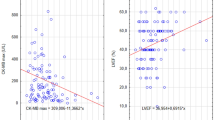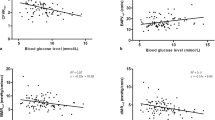Abstract
Background
Although acute hyperglycemia (AHG) is associated with poor outcomes in ST-segment elevation myocardial infarction (STEMI) patients, underlying mechanisms have not been fully elucidated. We investigated the influence of AHG on myocardial microcirculation in reperfused STEMI patients.
Methods and Results
Thirty-four STEMI patients were divided into 2 groups according to the presence (Group H, n = 11) or the absence (Group L, n = 23) of AHG. Myocardial blood flow (MBF) and myocardial flow reserve (MFR) in the infarct-related area were compared between 2 groups, using 13N-ammonia positron emission tomography. Wall motion abnormality scores (WMASs) and end-diastolic volume indices (EDVI) were also assessed at 1 and 6 months after the onset. Although resting MBF was similar, MFR was lower in Group H than in Group L (1.69 ± 0.37 vs 2.39 ± 0.56, P = .001). WMAS was greater in Group H than in Group L at both 1 month (7.4 ± 3.7 vs 3.7 ± 3.0, P = .011) and 6 months (7.3 ± 3.9 vs 3.1 ± 3.4, P = .015). EDVI tended to be greater in Group H than in Group L at 6 months (103.8 ± 42.9 vs 73.9 ± 16.0 mL/m2, P = .071). Multivariate analysis showed AHG to be independently associated with low MFR.
Conclusions
In STEMI patients, AHG impaired myocardial microcirculation, leading to poor functional recovery and remodeling despite successful reperfusion.





Similar content being viewed by others
References
Gruppo Italiano per io Studio della Streptochinasi neli’Infarto Miocardico (GISSI). Effectiveness of intravenous thrombolytic treatment in acute myocardial infarction. Lancet 1986;1:397-401.
Ito H, Tomooka T, Sakai N, Yu H, Higashino Y, Fujii K, et al. Lack of myocardial perfusion immediately after successful thrombolysis: A predictor of poor recovery of left ventricular function in anterior myocardial infarction. Circulation 1992;85:1699-705.
Straumann E, Kurz DJ, Muntwyler J, Stettler I, Furrer M, Naegeli B, et al. Admission glucose concentrations independently predict early and late mortality in patients with acute myocardial infarction treated by primary or rescue percutaneous coronary intervention. Am Heart J 2005;150:1000-6.
Ishihara M, Kojima S, Sakamoto T, Asada Y, Tei C, Kimura K, et al. Acute hyperglycemia is associated with adverse outcome after acute myocardial infarction in the coronary intervention era. Am Heart J 2005;150:814-20.
Ishihara M, Kagawa E, Inoue I, Kawagoe T, Shimatani Y, Kurisu S, et al. Impact of admission hyperglycemia and diabetes mellitus on short- and long-term mortality after acute myocardial infarction in the coronary intervention era. Am J Cardiol 2007;99:1674-9.
Schiele F, Descotes-Genon V, Seronde MF, Blonde MC, Legalery P, Meneveau N, et al. Predictive value of admission hyperglycaemia on mortality in patients with acute myocardial infarction. Diabet Med 2006;23:1370-6.
Ishihara M, Inoue I, Kawagoe T, Shimatani Y, Kurisu S, Nishioka K, et al. Impact of acute hyperglycemia on left ventricular function after reperfusion therapy in patients with a first anterior wall acute myocardial infarction. Am Heart J 2003;146:674-8.
Nakamura T, Ako J, Kadowaki T, Funayama H, Sugawara Y, Kubo N, et al. Impact of acute hyperglycemia during primary stent implantation in patients with ST-elevation myocardial infarction. J Cardiol 2009;53:272-7.
L’Huillier I, Zeller M, Mock L, Beer JC, Laurent Y, Sicard P, et al. Relation of hyperglycemia to ST-segment resolution after reperfusion for acute myocardial infarction (from Observatoire des Infarctus de Côte-d’Or Survey [RICO]). Am J Cardiol 2006;98:167-71.
Iwakura K, Ito H, Ikushima M, Kawano S, Okamura A, Asano K, et al. Association between hyperglycemia and the no-reflow phenomenon in patients with acute myocardial infarction. J Am Coll Cardiol 2003;41:2300.
Neumann FJ, Kósa I, Dickfeld T, Blasini R, Gawaz M, Hausleiter J, et al. Recovery of myocardial perfusion in acute myocardial infarction after successful balloon angioplasty and stent placement in the infarct-related coronary artery. J Am Coll Cardiol 1997;30:1270-6.
Ishihara M, Kojima S, Sakamoto T, Kimura K, Kosuge M, Asada Y, et al. Comparison of blood glucose values on admission for acute myocardial infarction in patients with versus without diabetes mellitus. Am J Cardiol 2009;104:769-74.
Austen WG, Edwards JE, Frye RL, Gensini GG, Gott VL, Griffith LS, et al. A reporting system on patients evaluated for coronary artery disease. Report of the Ad Hoc Committee for Grading of Coronary Artery Disease, Council on Cardiovascular Surgery, American Heart Association. Circulation 1975;51:5-40.
Hindman NB, Schocken DD, Widmann M, Anderson WD, White RD, Leggett S, et al. Evaluation of a QRS scoring system for estimating myocardial infarct size. V. Specificity and method of application of the complete system. Am J Cardiol 1985;55:1485-90.
Sevilla DC, Wagner NB, Pegues R, Peck SL, Mikat EM, Ideker RE, et al. Correlation of the complete version of the Selvester QRS scoring system with quantitative anatomic findings for multiple left ventricular myocardial infarcts. Am J Cardiol 1992;69:465-9.
Uyarel H, Cam N, Okmen E, Kasikcioglu H, Tartan Z, Akgul O, et al. Level of Selvester QRS score is predictive of ST-segment resolution and 30-day outcomes in patients with acute myocardial infarction undergoing primary coronary intervention. Am Heart J 2006;151:1239.
Geshi T, Nakano A, Uzui H, Okazawa H, Yonekura Y, Ueda T, et al. Relationship between impaired microvascular function in the non-infarct-related area and left-ventricular remodeling in patients with myocardial infarction. Int J Cardiol 2008;126:366-73.
Nakano A, Lee JD, Shimizu H, Yonekura Y, Ueda T. Clinical significance of augmented fluorine-18 deoxyglucose uptake in remote normoperfused myocardium in patients with acute coronary syndrome under fasting conditions. J Nucl Cardiol 2000;7:454-60.
Choi Y, Huang SC, Hawkins RA, Kim JY, Kim BT, Hoh CK, et al. Quantification of myocardial blood flow using 13N-ammonia and PET: Comparison of tracer models. J Nucl Med 1999;40:1045-55.
Okazawa H, Takahashi M, Hata T, Sugimoto K, Kishibe Y, Tsuji T. Quantitative evaluation of myocardial blood flow and ejection fraction with a single dose of (13)NH(3) and gated PET. J Nucl Med 2002;43:999-1005.
Hattori N, Bengel FM, Mehilli J, Odaka K, Ishii K, Schwaiger M, et al. Global and regional functional measurements with gated FDG PET in comparison with left ventriculography. Eur J Nucl Med 2001;28:221-9.
Armiger LC, Gavin JB. Changes in the microvasculature of ischemic and infarcted myocardium. Lab Invest 1975;33:51-6.
Hellstrom HR. The injury-spasm (ischemia-induced hemostatic vasoconstrictive) and vascular autoregulatory hypothesis of ischemic disease. Resistance vessel-spasm hypothesis of ischemic disease. Am J Cardiol 1982;49:802-10.
Engler RL, Schmid-Schönbein GW, Pavelec RS. Leukocyte capillary plugging in myocardial ischemia and reperfusion in the dog. Am J Pathol 1983;111:98-111.
Tinsley JH, Hunter FA, Childs EW. PKC and MLCK-dependent, cytokine-induced rat coronary endothelial dysfunction. J Surg Res 2009;152:76-83.
Ishihara M, Inoue I, Kawagoe T, Shimatani Y, Kurisu S, Hata T, et al. Is admission hyperglycaemia in non-diabetic patients with acute myocardial infarction a surrogate for previously undiagnosed abnormal glucose tolerance? Eur Heart J 2006;27:2413-9.
Kosuge M, Kimura K, Kojima S, Sakamoto T, Matsui K, Ishihara M, et al. Effects of glucose abnormalities on in-hospital outcome after coronary intervention for acute myocardial infarction. Circ J 2005;69:375-9.
Mizock BA. Alterations in fuel metabolism in critical illness: Hyperglycaemia. Best Pract Res Clin Endocrinol Metab 2001;15:533-51.
Feener EP, King GL. Vascular dysfunction in diabetes mellitus. Lancet 1997;350:SI9-13.
Kersten JR, Montgomery MW, Ghassemi T, Gross ER, Toller WG, Pagel PS, et al. Diabetes and hyperglycemia impair activation of mitochondrial K(ATP) channels. Am J Physiol Heart Circ Physiol 2001;280:H1744-50.
Shechter M, Merz CN, Paul-Labrador MJ, Kaul S. Blood glucose and platelet-dependent thrombosis in patients with coronary artery disease. J Am Coll Cardiol 2000;35:300-7.
Nishikawa T, Edelstein D, Du XL, Yamagishi S, Matsumura T, Kaneda Y, et al. Normalizing mitochondrial superoxide production blocks three pathways of hyperglycaemic damage. Nature 2000;404:787-90.
Cai H, Harrison DG. Endothelial dysfunction in cardiovascular diseases: The role of oxidant stress. Circ Res 2000;87:840-4.
Oliver MF, Opie LH. Effects of glucose and fatty acids on myocardial ischaemia and arrhythmias. Lancet 1994;343:155-8.
Malmberg K, Norhammar A, Wedel H, Rydén L. Glycometabolic state at admission: Important risk marker of mortality in conventionally treated patients with diabetes mellitus and acute myocardial infarction: Long-term results from the Diabetes and Insulin-Glucose Infusion in Acute Myocardial Infarction (DIGAMI) study. Circulation 1999;99:2626-32.
Malmberg K, Rydén L, Wedel H, Birkeland K, Bootsma A, Dickstein K, et al. Intense metabolic control by means of insulin in patients with diabetes mellitus and acute myocardial infarction (DIGAMI 2): Effects on mortality and morbidity. Eur Heart J 2005;26:650-61.
Ishii H, Ichimiya S, Kanashiro M, Amano T, Matsubara T, Murohara T. Effects of intravenous nicorandil before reperfusion for acute myocardial infarction in patients with stress hyperglycemia. Diabetes Care 2006;29:202-6.
Zhao JL, Yang YJ, Pei WD, Sun YH, Chen JL. The effect of statins on the no-reflow phenomenon: An observational study in patients with hyperglycemia before primary angioplasty. Am J Cardiovasc Drugs 2009;9:81-9.
Acknowledgments
We are grateful to Mr. Katsuya Sugimoto and all other cyclotron staff members for their technical assistance. We also wish to thank the technical and nursing staff of our cardiac catheterization laboratory and coronary care unit for their highly skilled assistance.
Author information
Authors and Affiliations
Corresponding author
Rights and permissions
About this article
Cite this article
Sarazawa, K., Nakano, A., Uzui, H. et al. Acute hyperglycemia causes microvascular damage, leading to poor functional recovery and remodeling in patients with reperfused ST-segment elevation myocardial infarction. J. Nucl. Cardiol. 19, 507–514 (2012). https://doi.org/10.1007/s12350-012-9525-x
Received:
Accepted:
Published:
Issue Date:
DOI: https://doi.org/10.1007/s12350-012-9525-x




